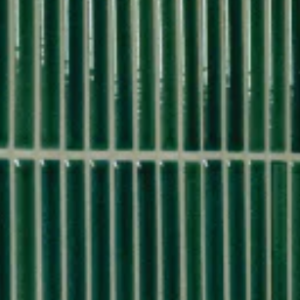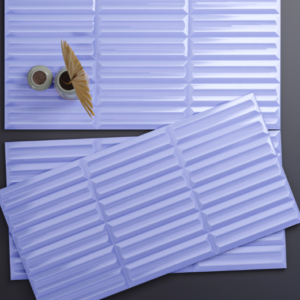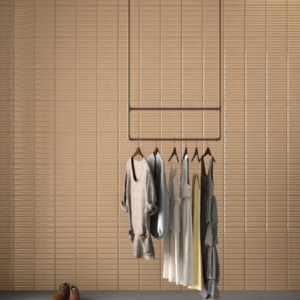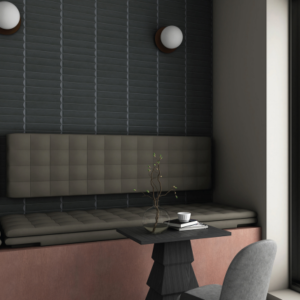CERAMIC TILES
Ceramic tile is a heat-hardened tile made of clay that is frequently glazed for protection.Compared to porcelain tile, ceramic tile is created with a generally coarser clay mixture. Although not in the same proportion as porcelain tile, it does contain fine kaolin clay. It also lacks certain clay additions seen in porcelain.
Ceramic tile is typically heated between 1,800 and 2,000 degrees Fahrenheit, which is a lower temperature than porcelain tile.
The ceramic tile’s face will withstand water as long as it is glazed and in good condition. The rear or side of the tile that is not glazed will not withstand water.
Here are some features of Ceramic Tiles:-
Features of Ceramic Tiles
1. Versatility:
- Available in countless colors, sizes, shapes, and patterns.
- Suitable for walls, floors, backsplashes, and showers.
2. Affordability:
- Generally more affordable than porcelain and natural stone tiles.
- Wide range of options to fit different budgets.
3. Ease of Maintenance:
- Easy to clean with regular sweeping and mopping.
- Resistant to stains and relatively low maintenance.
4. Durability:
- Durable and long-lasting when properly installed and maintained.
- Resistant to moisture and humidity, ideal for bathroom environments.
5. Aesthetic Appeal:
- Can mimic the look of other materials like stone and wood.
- Offers various finishes such as glossy, matte, and textured.
Design Ideas for Ceramic Tiles in Bathrooms
1. Subway Tiles:
- Classic rectangular tiles arranged in a brick-like pattern.
2. Mosaic Tiles:
- Small tiles often arranged in intricate patterns or images.
3. Patterned Tiles:
- Tiles with intricate designs, often inspired by Moroccan or Spanish styles.
4. Hexagon Tiles:
- Six-sided tiles that add geometric interest.
5. Large Format Tiles:
- Tiles larger than the standard size, often 12×24 inches or bigger.
Ceramic roof tiles: architectural style and design
These tiles have been used for generations in Spain, and their beautiful design contrasts with the somber aspect of the black asphalt shingles. Both traditional and contemporary homes constructed in the Spanish or Southwestern architectural traditions have ceramic tile roofs. When added to finished Mediterranean-style homes, they also look good.
Ceramic roof tiles are a durable and attractive roofing option that has been used for centuries. They provide a classic look and are known for their longevity, weather resistance, and aesthetic appeal. Here’s a comprehensive overview of ceramic roof tiles, including their features, types, design ideas, pricing, and installation tips.
Features of Ceramic Roof Tiles
1. Durability:
- Long-lasting and can endure extreme weather conditions.
- Resistant to fire, insects, and rot.
2. Aesthetic Appeal:
- Available in various colors, shapes, and finishes.
- Offers a traditional, elegant look suitable for many architectural styles.
3. Energy Efficiency:
- Provides natural insulation, helping to keep homes cooler in the summer and warmer in the winter.
- Can reduce energy costs.
4. Low Maintenance:
- Requires minimal maintenance once installed.
- Resistant to mold, mildew, and staining.
5. Environmental Benefits:
- Made from natural clay and other eco-friendly materials.
- Can be recycled at the end of their lifespan.
Types of Ceramic Roof Tiles
1. Spanish/Mission Tiles:
- Description: Curved tiles that interlock to form a distinctive pattern.
- Appearance: Typically red or brown, but available in various colors.
2. Flat Shingles:
- Description: Flat tiles that overlap, creating a smooth, uniform appearance.
- Appearance: Available in various sizes and colors.
3. Pantiles:
- Description: S-shaped tiles that create a ripple effect on the roof.
- Appearance: Offers a distinctive, wavy look.
4. Roman Tiles:
- Description: Similar to Spanish tiles but with a flatter profile.
- Appearance: Provides a clean, elegant look.
5. Interlocking Tiles:
- Description: Designed to fit together securely, reducing the risk of leaks.
- Appearance: Available in multiple shapes and colors.
FAQs
What is the average price of roof tiles?
The average price of roof tiles in India can vary significantly depending on several factors. Here’s a breakdown to give you an idea:
Price Range: A typical range for roof tiles in India can be ₹100 per square foot to ₹250,000 per square foot. However, this is a broad spectrum, and the actual cost will depend on the specific type of tile you choose.
Factors Affecting Price:
• Material:
- Clay: The most common and affordable option, typically ranging from ₹100 to ₹250 per square foot.
- Concrete: More durable than clay, but can be slightly more expensive (₹150-₹400 per square foot).
- Metal: Offers excellent durability and longevity, but is the most expensive option (₹500+ per square foot). There are various types of metal roofing, with copper or zinc being on the higher end.
- Other materials: Natural slate or stone tiles can be even more expensive than metal roofing, depending on the specific type and rarity of the stone.
- Design and Complexity: Simple flat tiles are less expensive than those with intricate shapes or profiles.
- Size: Larger tiles tend to cost more due to increased material usage.
What is the price range for cooling tiles?
Cooling tiles, also known as cool roof tiles, are designed to reflect sunlight and absorb less heat, helping to reduce cooling costs in your building. The price range for cooling tiles in India can vary depending on several factors, but here’s a general idea:
Price Range:
₹28 – ₹69 per square foot: This is a common range you’ll find for basic cooling tiles made from materials like clay or ceramic.
Upwards of ₹100 per square foot: This applies to premium cooling tiles made from specific materials or with advanced coatings that offer higher solar reflectance and heat reduction properties.
Factors Affecting Price:
Material:
- Clay/Ceramic: These are the most common and affordable cooling tiles.
- Concrete: Some concrete tiles may have cooling properties, but the price range might be similar to clay/ceramic options.
- Other materials: Some manufacturers might offer cooling tiles made from recycled materials or with special coatings, which could be priced higher than traditional clay or ceramic options.
- Design and Finish: While most cooling tiles prioritize functionality over aesthetics, some might have a colored finish or a textured surface, which could influence the price.
What is the average price of roof floor tiles per square foot?
There seems to be a misunderstanding here. There isn’t a common roofing material called “roof floor tiles.” Roofing materials are typically designed for outdoor use on slanted roofs, while floor tiles are for indoor use on flat surfaces.
Here’s a clarification:
- Roof Tiles: As discussed earlier, the average price of roof tiles in India can vary significantly depending on the material (clay, concrete, metal, etc.) and other factors. It can range from ₹100 to ₹250,000 per square foot, with clay and concrete being the most affordable options (generally under ₹500 per square foot).
- Floor Tiles: The average price of floor tiles in India also varies depending on the material (ceramic, porcelain, vinyl, etc.), size, design, and brand. Here’s a general breakdown:
- Ceramic Floor Tiles: ₹30 – ₹150 per square foot (affordable option)
- Porcelain Floor Tiles: ₹50 – ₹700+ per square foot (wider range based on quality and design)
- Vinyl Floor Tiles: ₹20 – ₹100+ per square foot (often budget-friendly)
What is the average price of ceramic roof tiles?
Ceramic roof tiles are a common and affordable option in India. The average price can vary depending on several factors, but here’s a breakdown to give you an idea:
Price Range:
A typical range for ceramic roof tiles in India can be ₹15 – ₹75 per square foot. This makes them a budget-friendly choice compared to other roofing materials like metal or slate.
Factors Affecting Price:
- Quality and Grade: Higher quality ceramic tiles with better durability and finer finishes will be more expensive than lower-grade options.
- Size and Design: Larger ceramic tiles tend to cost more due to increased material usage. Similarly, intricately designed or textured tiles might be slightly pricier than plain ones.
- Brand and Retailer: Different brands and retailers will have varying pricing structures
Active Filters:
Clear Filters
-
Fes De Vert Subway Tile 3*12 Inch
₹240.00/ Sqft -
Fes De Rose Subway Tile 3*12 Inch
₹240.00/ Sqft -
Fes De Nut Subway Tile 3*12 Inch
₹240.00/ Sqft -
Fes De Noir Subway Tile 3*12 Inch
₹240.00/ Sqft -
Fes De Latte Subway Tile 3*12 Inch
₹240.00/ Sqft -
Fes De Gris Subway Tile 3*12 Inch
₹240.00/ Sqft -
Fes De Blue Subway Tile 3*12 Inch
₹240.00/ Sqft -
Fes De Blanc Subway Tile 3*12 Inch
₹240.00/ Sqft -
Liner Pine Ceramic Tile 12 Inch x 12 Inch
₹100.00/ Sqft -
Liner Navy Ceramic Tile 12 Inch x 12 Inch
₹100.00/ Sqft -
Liner Jade Ceramic Tile 12 Inch x 12 Inch
₹100.00/ Sqft -
Liner Blue Ceramic Tile 12 Inch x 12 Inch
₹100.00/ Sqft -
Capsule Dusk Ceramic Tile 12 Inch x 12 Inch
₹100.00/ Sqft -
Capsule Brown Ceramic Tile 12 Inch x 12 Inch
₹100.00/ Sqft -
Roof Black Ceramic Tile 12 Inch x 12 Inch
₹100.00/ Sqft -
Jorde Aque Ceramic Tile 12 Inch x 12 Inch
₹100.00/ Sqft -
Bumpy Cipra Ceramic Tile 12 Inch x 12 Inch
₹100.00/ Sqft -
Terra Vento Maquillaje Matt Tile 12 x 36 Inch
₹600.00/ Sqft -
Terra Maquillaje Matt Tile 12 x 36 Inch
₹500.00/ Sqft -
Terra Blanco Vento Matt Tile 12 x 36 Inch
₹600.00/ Sqft -
Terra Blanco Matt Tile 12 x 36 Inch
₹500.00/ Sqft -
Terra Salvia Matt Tile 12 x 36 Inch
₹500.00/ Sqft -
Terra Salvia Vento Matt Tile 12 x 36 Inch
₹600.00/ Sqft -
Terra Beige Vento Matt Tile 12 x 36 Inch
₹600.00/ Sqft -
Terra Beige Matt Tile 12 x 36 Inch
₹500.00/ Sqft -
Terra Azul Vento Matt Tile 12 x 36 Inch
₹600.00/ Sqft -
Terra Azul Matt Tile 12 x 36 Inch
₹500.00/ Sqft -
Waffer Topping Matt Tile 12 x 38 Inch
₹600.00/ Sqft -
Cialda Topping Matt Tile 12 x 38 Inch
₹3,000.00/ Sqft -
Coventry Black Fluted Matt Tile 12 x 24 Inch
₹120.00/ Sqft -
Coventry Black Sattin Matt Tile 12 x 24 Inch
₹120.00/ Sqft -
Coventry Oyster Sattin Matt Tile 12 x 24 Inch
₹120.00/ Sqft -
Chester Camel Sattin Matt Tile 12 x 24 Inch
₹120.00/ Sqft -
Chester Taupe Sattin Matt Tile 12 x 24 Inch
₹120.00/ Sqft
Showing 1–36 of 481 results


































































